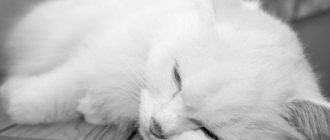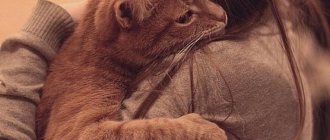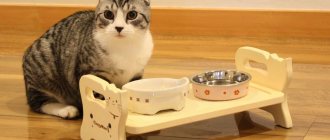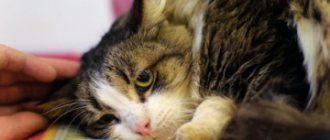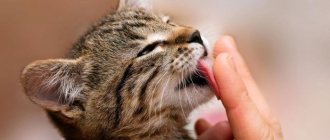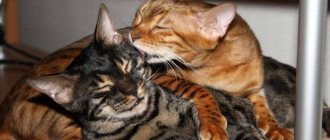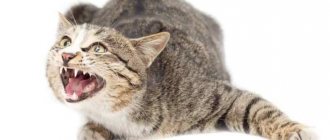With good health and proper care, the life expectancy of a cat can reach 18-19 years. There are cases when cats lived more than 20. These are real long-livers and a great rarity. It’s very sad when everyone’s favorite grows old before our eyes, his health deteriorates and one day he dies. You need to know how cats die in order to psychologically prepare for the departure of your pet and alleviate his condition as much as possible in the last days.
Causes and characteristic symptoms of approaching death
The lifespan and death of domestic cats, like all other living creatures, depends on many factors. These include natural aging, genetics, injury, poisoning, illness, and even psychological causes such as chronic stress.
The diseases that most often cause death in cats include:
- Chronic renal failure resulting from urolithiasis. Sterilized animals have a metabolic disorder, due to which they require specialized nutrition and drinking regimen. If you continue to feed your cat as usual, stones form in the kidneys and bladder, which cause pain, severe inflammation, impaired urine flow, and swelling. If treatment is started immediately after the first symptoms are detected, the disease can be managed.
- Cancerous tumors that can affect various organs. Just like in humans, cancer in cats can occur at any age. Most often, malignant neoplasms are detected in cats in the uterus, lymph nodes (lymphoma), mammary glands, brain and liver. It will not be possible to completely cure the animal, but timely surgery and medication will significantly prolong the pet’s life and alleviate its condition.
- Bacterial, viral and fungal infections, to which kittens, unvaccinated and free-ranging adult cats are most susceptible. A sick animal definitely needs the help of a veterinarian and medicine. The body can cope with mild infections on its own in 4-5 days, otherwise the condition deteriorates very quickly, becomes critical and it will no longer be possible to help the pet. There are infections that develop rapidly. An animal that is vigorous in the morning already shows severe symptoms of intoxication by the evening.
Why the pet suddenly died will only be known after an autopsy at the veterinary clinic. It’s better not to take risks and consult a specialist.
Any change in the behavior of a domestic cat should be a reason for careful observation. This will help to recognize both the onset of the disease and the symptoms of dying in time.
An elderly pet or one suffering from a chronic illness behaves quite characteristically before its death. The owners note this and mentally prepare for the departure of a family member.
The following signs indicate imminent death:
- Significant slowing of heart rate. Normally, a cat's heart rate is 130-230 per minute. If the heart beats 60 times or less, then the animal dies. You can determine your pet's pulse by pressing your fingers tightly to the chest under the left front paw. Usually, 15 seconds are taken for measurements and counted down, after which the result is multiplied by 4. A slow heart rate is associated with severe hypotension, but it is impossible to measure a cat’s blood pressure without special devices.
- Frequent hoarse breathing. 20-30 inhalations and exhalations per minute are considered normal for a healthy animal. If the cat breathes frequently, sticks out its tongue, and wheezing, whistling or gurgling sounds are heard, then we are talking about severe hypoxia and dysfunction of the cardiovascular system. Sometimes a dry cough appears when exhaling. This indicates the development of obstruction and bronchopulmonary insufficiency.
- Critical decrease in body temperature. When taking measurements, the thermometer will show values significantly lower than the required 37.5. A dying cat's paw pads and ears will be cold.
- Refusal of food and water. Several days before death, the animal does not touch the bowls. The urine becomes dark, the stool is absent or very dry and streaked with blood. Usually, shortly before death, pets suddenly and noticeably lose weight, the pelvic bones and spine begin to stick out, and the sides collapse. Some cats take food and drink from the hands of their owners, but they do this more out of love and a desire to please.
- The toilet is in the wrong place. A clean and well-mannered pet may begin to go to the toilet past the tray, and urination may occur in its sleep.
- Pungent or putrid odor. Before death, the cat’s metabolism goes astray, toxins are not eliminated, and the breakdown of proteins from the muscles begins. People dying from cancer smell especially strongly. With chronic renal failure, a strong ammonia odor appears. The kidneys fail to cope with their filtering function, urine retention occurs, and waste products are released through sweat and skin secretions.
- Ungroomed appearance of fur. The cat stops licking itself, the fur becomes dull and rolls into icicles and tangles. In some cases, the underfur comes out in shreds to the point of bald spots. The eyes droop, the gaze becomes dull and cloudy. A previously affectionate cat may stop recognizing family members, lie detachedly in one place, and completely withdraw into itself. The pupils of a dying animal will lose their reaction to light and will be greatly dilated.
- Loss of coordination. Animals, before they die, may lose orientation in space, bump into objects, stagger, and fall when walking.
- Convulsions, seizures, prolonged sleep or loss of consciousness. The agony can last for several hours. In it, the cat is tormented by convulsions, after which it falls into oblivion for a while. Saliva may appear in the mouth as a white foam.
- Particular tenderness and affection towards the owner. The cat foresees its death and fawns over the person, saying goodbye. Some seemingly weakened pets begin to run and play. So they want to show a kind of concern for the mental state of a loved one, showing that life goes on.
- Craving for loneliness. Cats that have access to the outdoors prefer to move away from home before they die. Pets also hide, looking for dark corners where no one will see them.
Signs associated with the death of a cat in the house
There are many signs associated with the death of these animals in the house:
- a cat that dies naturally takes with it troubles, envy, slander and the evil eye;
- a pet dying due to the fault of family members means theft;
- an animal killed due to household appliances means trouble in business;
- a cat accidentally falling to its death from a window is a sign warning of the imminent dissolution of a marriage;
- a pet who has died as a result of poisoning warns the owner that new acquaintances can bring him a lot of problems;
- An animal that died due to a fight with relatives means disagreements with friends.
To believe or not in the listed signs is a personal matter for everyone. It’s better to try to prevent such a sad event, and if this is impossible, treat it wisely.
Unfortunately, nothing in the world lasts forever and death accompanies us throughout our lives. Of course, the loss of a loved one cannot be compared with the departure of another cat into the world. But sometimes you become so attached to your beloved pet that you consider it a member of the family.
Owners rarely have to watch cats die. And all because most of them prefer to face death far from home, completely alone. But this does not always happen, since not everyone has the opportunity to go outside. To understand that the cat is dying and the time has come to let him go on his last journey, specific symptoms of his approaching death will help. After all, it is important to provide proper care for him during this difficult period.
Where and why do purrs go before they die?
In the wild, a dying cat seeks solitude. This is completely natural, because the animal is weakening and can no longer protect itself from predators. It finds a quiet, secluded place to hide and quietly leave . It is possible that death is perceived as a sign of illness. Therefore, the cat leaves its home to rest.
Pets also retain this instinct. And if they do not go outside, then the last refuge may be a closet or the far corner behind the furniture. At the same time, the animal rarely comes out of hiding and sleeps almost around the clock. This suspicious symptom should immediately alert you.
There is an opinion that by leaving, cats purposefully protect their owners from moral suffering.
The British even have a sign that the death of a cat in the house attracts trouble. But you shouldn’t believe in these superstitions, because it’s unlikely that a pet would wish bad things on its friend. It’s just that not everyone manages to leave the fireplace unnoticed, especially if the old man is weakened and cannot move independently.
Signs of imminent death
You can know that a cat is dying by the presence of a combination of certain symptoms. If your pet is over 12–14 years old, then you need to carefully monitor its behavior and health. Some felines live up to 25 years, but this happens very rarely.
Before you prepare for the worst, you should take him to the vet. It is likely that the pet is simply seriously ill, but it can be cured . Timely therapy is important for recovery, so do not delay going to the clinic or calling a specialist at home. For example, older cats often develop chronic pathologies that are similar to signs of impending death. However, if remission is achieved, the animal can live several more years without suffering or pain.
Why do cats go away and hide before they die?
The most logical explanation for an old or sick cat's desire to leave the house is related to the ancient instinct that domestic pets inherited from their wild ancestors.
The animal feels and understands its vulnerability well in this state. Intuitively, they look for a secluded and safe place to lie down and not become prey to other predators. For the same reason, cats that have never been outside the walls of the house still look for a secluded corner.
Animal psychologists sometimes say that the desire to retire before death is associated with the independent and proud character of cats. They don't want to be seen as weak or dead.
Animals that are especially attached to their owners can thus protect them from sadness and grief.
There are also more mystical explanations for why a cat runs away from home. They are associated with the myth that these animals can foresee the future and see subtle worlds. Allegedly, in this way, they take upon themselves the misfortune that threatens the owners and their home, and die in their place.
Vital signs changed
Common symptoms in a dying cat include irregular heart rhythm, excessively high or low body temperature, and breathing problems. To accurately determine any deviations from the norm, you need to remember the animal's vital signs:
- Respiratory rate in adult cats: 20 to 42 breaths per minute.
- The heart beats at a rate of 140 to 200 beats per minute. A seriously ill or weakened cat's pulse may decrease significantly, indicating that death is approaching.
- Body temperature: from 38ºC to 39ºC. As the heart weakens, the temperature drops below 37.8°C.
Ways to make a dying cat feel better
Loving owners, as a rule, also understand that life is leaving their pet. They notice changes in the well-being and behavior of their furry friend. It is natural to want to do something to ease the last few hours.
You can say goodbye and send off your last journey with dignity by staying at home with the animal, perhaps taking a day off from work and canceling plans. It is better to hold a weakened cat in your arms longer, stroke it, and let it know how dear it is to you. Next to its person, the animal will feel safe and less anxious.
It is important to provide your cat with maximum comfort. To do this, it’s good to make a soft, warm bedding and put a heating pad with warm water in it. Once every two to three hours, the animal should be carried to the tray and to bowls with clean water and soft food.
If an old pet has incontinence, you should put an absorbent diaper on the bedding, which needs to be changed frequently.
A very weakened cat can be fed a specialized liquid diet and watered from a syringe. It is important to prevent parasites from getting into the ears and fur. They easily settle on a cat that has lost its natural immunity and are very annoying.
If the animal is seriously ill, you can increase the dose of analgesics or antispasmodics, or put in a dropper with a nutrient solution.
For palliative treatment, you can invite a veterinarian to your home. He will teach you how to properly care for a pet in serious condition. He will explain how to properly give injections, massage and feed sick cats.
How to care for your pet?
Caring for a dying cat requires effort, time and patience. She needs to be provided with a comfortable and soft place to rest. A cozy and warm lounger can be made from a blanket. Two rules must be followed:
- Regularly monitor the cleanliness of the sleeping area by washing the bedding daily.
- If an old cat cannot control urination, then lay disposable diapers over a soft base, changing them as they get dirty.
When an animal does not have enough strength to go to the toilet, you need help. To do this, he is carried by hand to the tray every 3–4 hours.
You should not violate the cat’s privacy if he tends to distance himself and does not respond to affection.
It is important to relieve your pet's pain symptoms. Cats rarely scream, meow, or otherwise show their distress. But they can be recognized if the following signs are present:
- decreased sociability and detachment;
- immobilization;
- looking at one point;
- dilated pupils;
- refusal to drink and eat;
- intermittent breathing.
Mr. Cat explains: funeral
After death, the animal’s body must be buried with dignity and, importantly, correctly. Many veterinary clinics offer pet cremation services, however, in the event that the animal died in the hospital or was euthanized there.
For those who have passed into another world at home, special pet cemeteries provide their services. They are in large cities. A place for a grave or an urn with ashes is provided for a fee. There, owners can set up a place in memory of their pet and visit him.
Most people prefer to bury their dead cats themselves. This is not recommended by sanitary and epidemiological standards, but is practiced everywhere.
There are a number of rules that will help you comply with environmental and ethical standards when burying remains:
- It is better to choose a part of the park that is deserted and far from walking trails and other animals. You can make a grave in the forest. Sometimes pets are buried with relatives in a human cemetery. You need to know that burying animals on the owner’s personal property is not prohibited, but for a similar act in a public place you will have to pay a fine.
- The grave must be deep enough, at least one meter, so that it will not be dug up by dogs or predatory animals attracted by the smell of decomposition. A shallow burial may be washed away by rain. It is very important to take care of the cleanliness of nearby ground sources. If there are springs or springs nearby, it is better to choose another place.
- A stone placed on the pet’s grave, a flower bed or a planted tree can play an aesthetic and memorable role. The owners will be able to visit the place where the pet is buried. This will help them get over the breakup easier.
2. Sloppiness and specific smell
A clear sign that something is wrong with the cat is a loss of hygiene skills. Some cats spend more time grooming than others. A complete loss of this behavior indicates problems.
When the functioning of a cat’s internal organs deteriorates, toxic substances accumulate in its body, resulting in an unpleasant odor. The breath and body of a dying animal emits an odor that increases over time as toxins accumulate in the body.
Psychological experience of loss
The loss of a pet has a serious impact on the emotional state of all family members. Don't hold back your emotions and tears. If you can’t survive the melancholy on your own, it is better to seek help from a psychologist. A good way to console yourself would be to spend time with your family or chat with cat owners who have already experienced a loss previously on a special forum or in a group on social networks.
Particular attention should be paid to the feelings of children. Due to their age and lack of life experience, they cannot cope with grief on their own. The death of a beloved friend becomes a serious psychological trauma. They begin to dream about the deceased animal, they see it in folded clothes or objects. Children mourn their pets for a long time and cannot switch to games or studies.
It is important for parents not to brush aside the problem, but to fully share the pain of loss with the baby, not to promise him a new kitten, but to warmly and lovingly remember the one who has passed away, and focus on the bright and happy moments of life together.
Elderly single people whose cat was their only companion and companion should receive full psychological support. The death of a cat increases the feeling of loneliness and sometimes leads to a devaluation of one’s own life and the desire to die after the pet.
In addition, suspicious old people begin to see the death of a pet as a bad omen, a terrible omen “the cat has died - wait for the dead person in the house.” Such manifestations of fears and superstitions can seriously affect health and cause exacerbation of chronic nervous diseases.
Some time after the loss, it is better to distribute the cat's things and toys to other families with animals.
However, this should not be done under any circumstances if the cat died from an infection. After a sick animal, things are disposed of.
It’s worth making a new friend after the pain of loss has completely smoothed out. If a person cannot remember his furry friend without tears, a new pet will not be able to bring him any comfort or joy. After the death of a beloved cat, time must pass.
There is a belief that when the heart calms down and the owner stops mourning his friend, the new cat will come to him.
There is little mysticism in this belief, it’s just that someone who has experienced a loss finally begins to look closely at kittens in advertisements and on the street. It is possible that you will like one of them.
Putting a cat to sleep: humanity or betrayal
If the cat is suffering and does not get up for a long time, then the owner has the right to use the procedure of euthanizing the animal. Each person perceives it differently: some consider it a real betrayal, others consider it as delivering the animal from suffering. However, sometimes the disease drags on, causing unbearable suffering to the cat. This especially applies to animals suffering from urolithiasis or oncology, in which the pet often dies in agony. In this case, the owner must do everything to alleviate the suffering of his four-legged friend. If you decide in favor of euthanasia, first ask your veterinarian if there is any other way to alleviate the cat's suffering.
If your cat is in pain, you need to ask your veterinarian how to alleviate its condition.
Absolutely correct! Of course, humanism should not be confused with a feeling of self-pity. That is, one should not confuse precisely the reluctance to euthanize an animal for medical reasons with the inability to make a decision about this and with the subsequent feeling of guilt.
Olga Zhuikova, owner of the nursery
https://www.svoboda.org/a/377148.html
When our cat got into a fight with a dog, his jaw was broken and his internal organs were damaged. The doctor said that nothing could be done to save him. He suggested euthanasia. But I couldn’t sign the animal’s verdict with my own hands. It seemed to me that since the cat is alive, it means he can recover. The cat eventually left to die, but my conscience remained calm.
Reviews from owners whose cats suffered before death
I put the cat to sleep... when I saw that she stopped eating and began to look sick... she was 17 years old. And if he runs, why? and good appetite? I have a dog (also old) with a small bump on her face and belly... she’s been jumping around for a year and a half now... I’m not taking her to euthanize yet... as soon as I see that she’s in pain and has difficulty getting up, I’ll take her right away.
Martian
https://www.woman.ru/home/animal/thread/3876141/
Take me to a normal clinic, what will they say? I pulled mine out of the other world for a year, kept the IVs twice a day until I got really bad (my kidneys failed), the doctors told me that it would last a maximum of 2 weeks, but the result was a year! Let them recommend medications, there is always a chance to extend the life of your family member a little! You will always have time to put it to sleep.
ovk
https://www.yaplakal.com/forum14/topic736780.html
I took her to another clinic, where at the first examination they said that the cat was going to die (((but they didn’t offer to put her to sleep, they gave her drippings again, gave several injections. They suggested severe poisoning, there was a problem with the intestines. Tomorrow they would take her to drip the kitty again. They gave hope that the cat would not die, and maybe even in the evening he will start to come to his senses
babaka
https://pikabu.ru/story/umiraet_koshka_1610414
Is it humane to euthanize a terminally ill cat?
Owners decide to resort to euthanasia of an animal as a last resort, when looking at the physical torture becomes unbearable. Injuries incompatible with normal life or the last stage of oncology, accompanied by unbearable pain, make people want to stop suffering overnight.
It is worth understanding the essence of the procedure. There are two ways:
- Placing the cat under deep anesthesia and, while asleep, administering a drug that stops the heart or respiratory muscles. This is the most humane and easiest way. The animal may begin to experience agony, but at the same time is in an unconscious state, which means that it does not experience fear or pain before death.
- An injection of ditilin - a substance that blocks the contraction of the respiratory muscles. At the same time, the cat is conscious, it understands what is happening to it, it feels suffocation, and therefore the fear of death. Before it subsides, the beast dies in agony.
Every living creature fights for its life to the last. If your pet has become frail due to age or chronic illness, it is humane to provide proper care and exercise patience. Euthanasia is a humane solution only in cases of unbearable suffering.
1111
About breathing before death
Measuring the breathing rate is also one way to understand that a cat is dying. In normal condition, the animal makes 20 to 30 exhalations per minute. But, unlike the pulse, the number of breaths will not decrease, but rather will increase. However, they will be weak, without depth.
This is due to the fact that a weakened heart also affects the efficiency of the respiratory system. Immediately before death, the breathing rate will drop, the number of breaths will be equal to the number of heartbeats.
About the desire for solitude
Before imminent death, the cat does not eat; it dies alone. Therefore, it is important to observe your pet. If an animal does not come to the owner’s sofa in the evenings, but tries to hide under a closet or in any other dark and difficult-to-reach place for humans, then this behavior (together with refusal to eat) indicates an imminent death.
But a cat in an apartment only dies in old age. If the animal is in the middle of life, then the desire for solitude indicates a disease in which it is difficult to tolerate noise and light. For example, about encephalitis, in which the animal hides and also refuses water and food. There are a number of other diseases with similar manifestations.
Hypoglycemia
Until the age of four weeks, the glycogen content in the kitten’s body is low. At this stage of life, muscle contractions, rather than the breakdown of glucose and brown fat, are responsible for heat production. Lack of glucose leads to hypoglycemia. A common cause is a large number of babies or insufficient milk from a nursing mother.
Glucose deficiency manifests itself:
- lethargy;
- passive behavior;
- convulsions;
- drop in body temperature.
At the initial stage, the baby can be saved by introducing additional complementary foods (natural milk substitute) and vitamins. If the disease is complicated, the veterinarian may prescribe an oral glucose solution. Injections under the skin at an early age are not recommended.
Hypothermia
The first weeks after birth, maternal warmth is vital for kittens, since the cubs’ own thermoregulation is far from perfect. Instinct dictates that mothers should not leave their furry babies alone for long periods of time. If the nest with babies is located in a cold place in the home, the cat can, on its own initiative, drag the offspring. The temperature in the room where babies grow should be maintained above 22 °C.
A kitten that finds itself far from the nest will have a gradual decrease in body temperature. The limit of 34 °C is a critical value at which the sucking reflex ceases to appear in a frostbitten kitten and digestive processes freeze. The mother will not care for such a child; without human help, the kitten will die. You can warm up your kitten using a heating pad and a warm blanket. Only after the animal’s temperature rises to 36 °C can you feed the baby formula using a pipette or bottle.
Attention! Giving food to a kitten (who is shivering) with a low temperature is dangerous. The milk will either enter the respiratory system or remain undigested inside the stomach. Both options will lead to immediate death.
Dehydration
Newborn animals must consume much more fluid than adults, as they rapidly lose moisture from the surface of the body. The average water consumption rate for a baby is 150 ml per kg of body weight, which is approximately twice as much as for an adult cat. Lack of milk or diarrhea leads to rapid development of dehydration. For these symptoms, your veterinarian will usually prescribe saline injections.
The air humidity in the room where the cubs grow must be at least 60%.
About refusing to drink and eat
Refusal of both food and water is one of the main harbingers of imminent death, which is what animal owners most often focus on. This is true; some time before its death, the pet stops eating and refuses water. Even if you offer something tasty and favorite, there will be no reaction.
Refusal to eat and drink causes the animal to look emaciated and lose weight. The cat's stomach drops. This point is important. If a cat’s tummy is swollen, you should immediately take your pet to the clinic or call a doctor to her house, rather than grieve.
What do psychologists say?
Psychologists often advise going to work in an animal shelter, putting all the things of the deceased cat out of sight, etc. But this is a very individual moment. You can go take care of the homeless or go to the cinema with friends.
Advice from psychologists does not take into account a person’s personality and what exactly he feels. Many owners of deceased animals do not experience good feelings when looking at living cats. Rather, they wonder why these cats are alive, but their beauty is no longer there. Of course, we are talking about emotions and feelings. With his mind, a person understands why his favorite is no longer around.
You need to take the advice of psychologists taking into account your own feelings. You can't force yourself to do something. If it’s completely unbearable at home, then you can go to another city for the weekend.
About incontinence
In a cat near death, control of the urinary tract may be lost. The same applies to the rectum.
Although the animal does not drink or eat, droplets of waste products are constantly or frequently released from it. First, the cat tries to lick them off the floor and clean up after itself. Then he stops paying attention.
A very important point for owners trying to figure out what to do if a cat dies. You should stock up on diapers for bedridden patients. They will be useful for maintaining hygiene not only at home, but also for the pet itself. The excrement released before imminent death is concentrated, because water does not enter the body. That is, these drops settle on the fur, and sometimes corrode the cat’s skin.
Tips for pet owners
Sometimes neither loved ones, nor a priest, nor a psychologist can find the key to the heart of a grieving person in order to alleviate his condition. But those who have experienced this - other cat owners - can help. Their advice:
- do not throw away the cat’s things, soon after his death you will want to see photos and toys of your beloved pet;
- do not communicate with those who disparage your feelings for the deceased cat; for many, the death of animals is unimportant;
- don’t get a kitten right away, give yourself time to grieve, because otherwise it will be just an escape from your own feelings.
Maternal factor
One of the causes of mortality is maternal misbehavior. It happens that a mother eats the weakest child in order to feed the rest of the offspring. This instinct was a feline inheritance from wild relatives. If a domestic cat has eaten the entire litter, the female must be spayed, otherwise this will happen again in the future.
An inexperienced mother can leave her children alone for a long time, in which case the pets develop hypothermia.
Insufficient quantity or low fat content of milk can also disrupt the normal development of children. The reason is too young age, exhaustion or obesity of the woman in labor.
Photo of a warm playpen with newborn kittens
